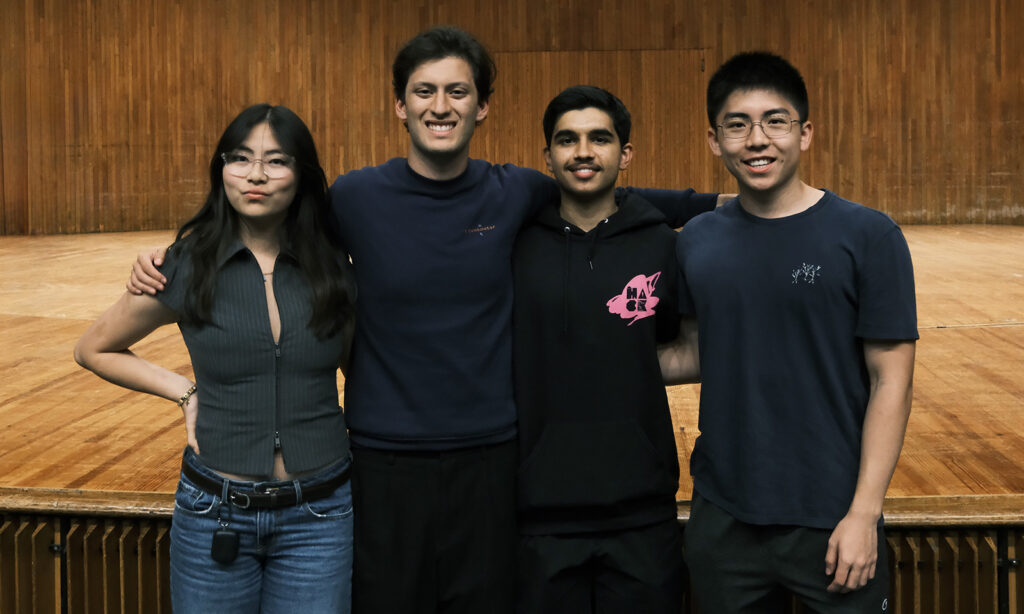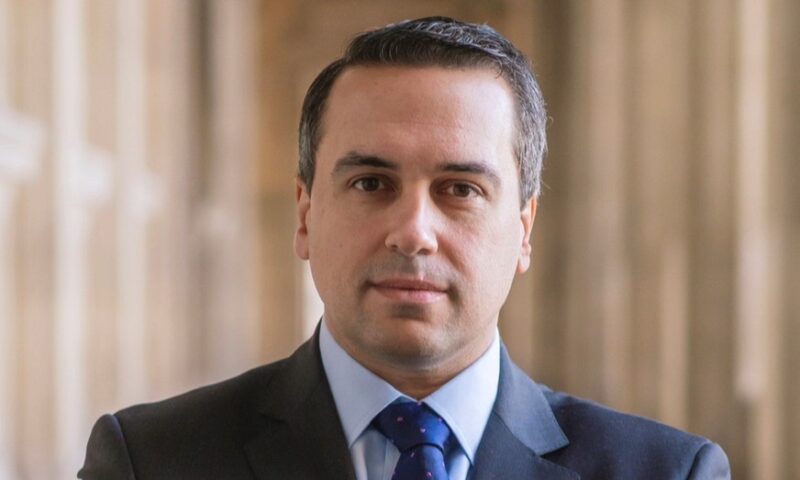McIntire second-year Pierce Brookins has some great ideas. And they’re the type of ideas that people take notice of for a reason: They’re impactful, practical, and innovative.
Take his submission for McIntire’s Generative AI for the Common Good Concept Competition during the fall 2024 semester, for instance. Back on Oct. 30 of last year, Brookins, together with then fellow first-year students Nelson Lattimer (Data Science ’28) and Nathan Wang (Engineering ’28), won the event for Accelerating Asylum, their inventive genAI multilingual solution designed to help ease the strain on border agents while assisting the high volume of migrants seeking refuge.
That experience at Rouss & Robertson Halls resulted in more opportunities for Brookins and his group, as they were invited to present again to executives at mobile application design and development company WillowTree, and then at the May 2025 edition of the Knowledge Continuum, hosted by McIntire’s Center for the Management of Information Technology (CMIT).
Each of those moments helped prepare him for what he and a team of undergrads representing three universities achieved in September 2025 at the Massachusetts Institute of Technology’s HackMIT event: first place in one of the competition’s sponsorship tracks for developing a novel handyman function for open-source smart glasses company Mentra Glass.
Quite a feat when you consider that HackMIT welcomes more than 1,000 highly motivated students from around the globe to create tech projects from scratch and present them—all within an action-packed 24 hours.
“It was very intense,” admits Brookins. “The competition pool is truly a gathering of the best of the best and the smartest people—so I was daunted. I was worried about whether I’d be able to even stand a chance and how it would go.”
Together with teammates William Hao and Atharv Mungale of The University of Texas at Austin and Jessica Young of Duke, Brookins reviewed their previous projects, the kinds of things they had developed, their strongest skills, and what they loved doing most to figure out how each could best support the team’s vision.
“Will and I took charge of the backend and developing the infrastructure,” he says. “Atharv was really able to do everything—he was very good across the board, and so he was helping wherever we needed help. Jessica was working on the front end and the companion app we built.”

Pierce Brookins (second from left) with his HackMIT teammates
Fertile Grounds, Designing for Two, and Crunch Time
The winning concept emerged from Brookins’ time brainstorming on Grounds, where he lives, when the idea came to him.
“Because we knew we wanted to do something with the smart glasses, I was looking around my apartment and thought, ‘What if in the future, 20 or 30 years down the line, we’re going to have robots, and we won’t even need to call a handyman to fix things? We can have a robot just do it for us. What if we build something where we can have the display embedded within the smart glasses? We can look at an item, and it’ll tell us, “This is how you do it. This is how you work with the item.”’”
His teammates were on board. They ran with it.
The biggest problem?
“We had two different models of glasses. We had a pair of Mentra Live, which are glasses that don’t have a display, but have a camera, and then we had Even Realities’ G1s, glasses that don’t have a camera, but have a display. So we needed to figure out and build a way that would seamlessly integrate between the two pairs of glasses,” he says, detailing the challenging technical hurdle that existed due to a few hardware limitations with Mentra’s open-source operating system.
“We wanted to create a seamless integration that would take the image from Mentra Live, parse out the barcode, and upload that into a database. And then we could use that with the Even Realities glasses,” he says. “So building out that seamless integration between the two glasses was extremely hard, especially with the time crunch. They had never seen anyone work with multiple pairs of glasses at the same time—in real time. We barely slept!”
Trying to make their product function for two different types of glasses led to a proliferation of bugs that took plenty of attention. Working in shifts, some members focused on the problems, while others grabbed quick naps.
Before they knew it, Saturday night turned into Sunday morning, and the time had come to present.
Seeing a Show-Stopping Idea
The judges from Mentra were coming to their booth. Because Brookins had the background in public speaking thanks to his Comm School training in communication and presenting, his team unanimously chose him to give their pitch.
To show the real-world applicability of their work, Brookins says he traded valuable coding time to run to a Target store in Boston to buy a ready-to-assemble dresser. A half-finished drawer as well as a LEGO set would show the judges just how the on-lens display would assist a person in building both items.
At the last minute, a new wrinkle presented itself. The judges appeared, but they were way behind on time and had only three minutes to afford the group for their presentation.
“So I just started giving them a firehose of information to explain every single feature we had built—but extremely fast. And they were wowed,” Brookins recalls.
They were so taken, in fact, that the judges from the company lingered to learn more about the features. Their entry’s grounding in practical use was one of the reasons Brookins thinks they stood out from the competition.
“Being able to physically show that this has real-world applicability was cool. And we were the only group out of anyone at HackMIT, to my knowledge, that had integration and used both pairs of smart glasses,” he says. “Using both of the glasses together really separated us from the crowd, along with being able to pitch really well and having a team that worked really well together.”
He ties that unique difference that made his team stand out back to an essential quality of the Comm School.
“McIntire is really big on tackling real-world business problems. And so while this wasn’t a business problem, per se, tackling real problems was essentially the reason why I was able to help my team come up with really good ideas. Many hackathons have super impressive technology, but [the projects] don’t seem like something that people would use in the real world,” he notes.
Coming up with something viable that could help others proved to be meaningful. “McIntire really instills a value of doing commerce for the common good,” he says. Yet being a part of HackMIT also left Brookins grateful for the experience of interacting with knowledgeable, excited people working on intriguing projects.
“Traveling to these hackathons is extremely hard to do, especially with my school schedule,” he says, noting that he was on his way to Harvard to take part in another hackathon, HackHarvard 2025, the following day and working to finish all of his academic work first. “Hackathons are so fun, not only because of what you’re able to build, but also because of the talent pool of people there,” he says. “There’s so many amazing people.”



